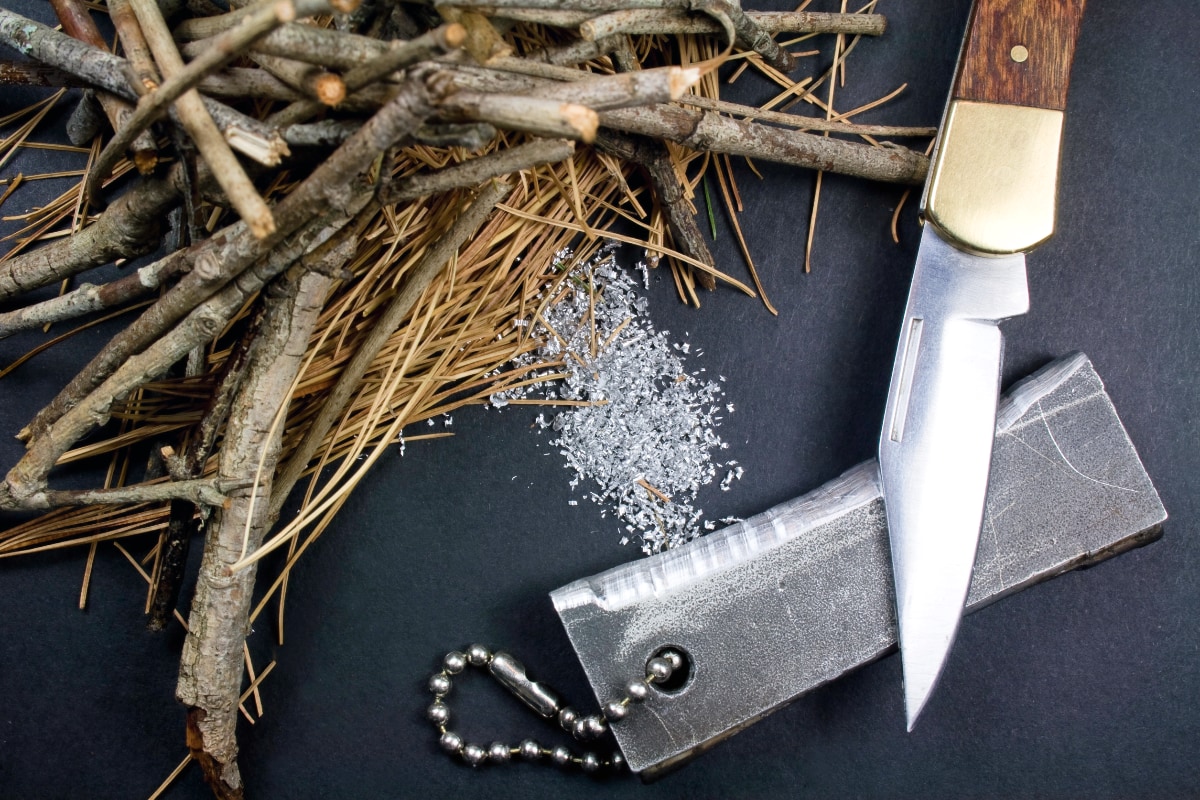Mastering fire-starting techniques is a crucial skill for anyone. Whether you are in a survival situation, simply enjoying the outdoors, hiking trails, or trying to earn your way into the final round of Survivor, knowing how to start a fire can make the difference between comfort and distress. In this article, we cover 12 essential fire-starting techniques that everyone should know or even master.

Using a Ferro Rod
One reliable fire-starting tool is a ferrocerium rod, or ferro rod. It produces a shower of hot sparks when scraped with a metal striker. To use a ferro rod, you need to prepare some dry tinder such as cotton balls, dry grass, or birch bark. Hold the ferro rod close to the tinder, scrape the rod with the striker at a 45-degree angle to produce sparks, and aim the sparks towards the tinder until it ignites.
Flint and Steel
Flint and steel is a traditional fire-starting method that involves striking a piece of steel against flint to create sparks. Select a hard steel striker and a sharp piece of flint. Place a char cloth near the point where sparks will land, then strike the flint against the steel to generate sparks. The sparks will catch on the char cloth, which you can then blow gently to ignite.
Magnesium Fire Starter
Magnesium fire starters are highly effective and work well in wet conditions. These consist of a block of magnesium with a ferro rod attached. To use one, shave off a pile of magnesium shavings with a knife, place the shavings on a base of dry tinder, and strike the attached ferro rod to ignite the magnesium shavings.
Bow Drill
The bow drill is an ancient friction fire-starting method that requires practice but is valuable for its reliability without modern tools. You need a spindle, a bow, a fireboard, and a socket. Cut a notch and a small depression in the fireboard, place the spindle in the notch, and use the bow to spin it rapidly. The friction generates heat, creating an ember that can ignite tinder.
Hand Drill
Another friction-based method is the hand drill, which is simpler but more physically demanding than the bow drill. Choose a straight spindle and a dry fireboard, then place the spindle in a notch on the fireboard and roll it between your palms. Spin the spindle quickly until an ember forms.
Fire Plough
The fire plough is a friction method where a stick is ploughed back and forth in a groove on a fireboard. Cut a straight groove in the fireboard, then rub a stick rapidly back and forth in the groove to create heat. The heat ignites the wood dust, forming an ember.
Using a Lens
Using a lens to start a fire harnesses the sun’s rays. A magnifying glass or a camera lens works well. Hold the lens to focus sunlight onto a small point on dry tinder, and maintain the focus until the tinder smolders and ignites.
Fire Piston
A fire piston compresses air to generate heat and ignite tinder. Place a small piece of char cloth or tinder in the piston chamber, push the piston quickly into the chamber, and remove the ember to transfer it to a tinder bundle.
Steel Wool and a Battery
Steel wool and a battery is a modern and effective fire-starting method. Use fine steel wool and a 9-volt battery. Touch the battery terminals to the steel wool, and the current will heat the steel wool, igniting it.
Chemical Fire Starters
Chemical fire starters, such as potassium permanganate and glycerin, create fire through chemical reactions. Combine potassium permanganate with glycerin, and the reaction will generate heat, igniting the mixture.
Electric Ignition
Electric ignition uses a small spark or heating element, typically from a survival lighter or electric arc device. Gather dry, fine tinder, use the electric device to produce a spark or heat, and aim the spark at the tinder until it ignites.
Using a Lighter or Matches
While basic, lighters and matches are essential tools for any prepper’s fire-starting arsenal. Ensure you have dry tinder and kindling, then use the lighter or strike the match to ignite the tinder.
| Technique | Tools Required | Difficulty | Conditions |
|---|---|---|---|
| Ferro Rod | Ferro rod, striker, tinder | Easy | All conditions |
| Flint and Steel | Flint, steel, char cloth | Medium | Dry conditions |
| Magnesium Fire Starter | Magnesium block, knife, tinder | Easy | Wet conditions |
| Bow Drill | Bow, spindle, fireboard, socket | Hard | Dry conditions |
| Hand Drill | Spindle, fireboard | Very Hard | Dry conditions |
| Fire Plough | Stick, fireboard | Hard | Dry conditions |
| Lens | Magnifying glass, dry tinder | Easy | Sunny conditions |
| Fire Piston | Fire piston, tinder | Medium | All conditions |
| Steel Wool and Battery | Steel wool, 9-volt battery | Easy | All conditions |
| Chemical Fire Starters | Potassium permanganate, glycerin | Medium | All conditions |
| Electric Ignition | Electric arc device, tinder | Easy | All conditions |
| Lighter or Matches | Lighter or matches, tinder | Easy | All conditions |
Mastering these fire-starting techniques enhances your preparedness for any situation. Practice regularly to ensure you can rely on these skills when needed.